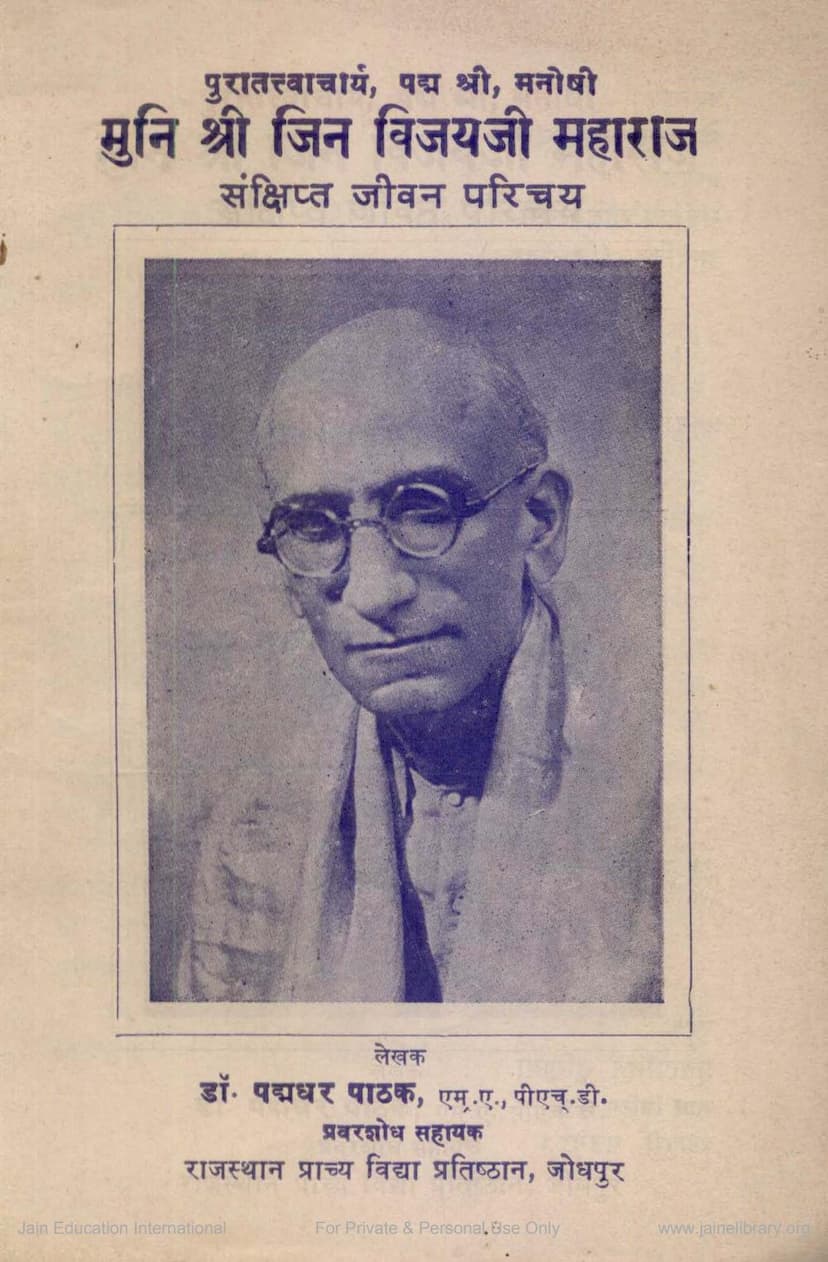Jinvijayji Ka Sankshipta Jivan Parichay
Added to library: September 2, 2025

Summary
Here's a comprehensive summary in English of the Jain text "Jinvijayji ka Sankshipta Jivan Parichay" by Padmadhar Pathak:
This book, "Jinvijayji ka Sankshipta Jivan Parichay" (A Brief Biography of Jinvijayji), authored by Dr. Padmadhar Pathak and published by Sarvoday Sadhnashram Chittorgadh, details the remarkable life of Muni Shri Jinvijayji Maharaj. Muni Shri Jinvijayji was a highly respected scholar, archaeologist, and spiritual leader, honored with the title "Padma Shri."
Early Life and Spiritual Inclination:
Born in the village of Rupaaheli in Mewar in V.S. 1644 (1587 AD), Muni Shri Jinvijayji (whose birth name is not explicitly mentioned in the provided text) was the son of Thakur Shri Vriddhisinhji, a Parmar Rajput, and Shrimati Rajkumari. His father passed away when he was young. During his father's illness, he met Yati Devihansji, under whose guidance he received his initial education. He developed deep reverence for Yati Devihansji, who was later injured and taken to Banen near Chittorgarh. Unfortunately, both Yati Devihansji and Muni Shri Jinvijayji's younger brother, Badal Singh, passed away in V.S. 1657 (1600 AD).
Quest for Knowledge and Spiritual Transformation:
In V.S. 1658 (1601 AD), near Athana village, he encountered Shaivayogi Mahant Khakhi Baba and became his disciple out of a strong desire for knowledge. However, after about six to eight months, he left the Mahant for various reasons. A significant turning point occurred in V.S. 1659 (1602 AD) when he embarked on a spiritual journey through Mewar and Malwa with some ascetics. Upon reaching Digthad village in the Dhar princely state, he met a disciplined monk of the Sthanakvasi Jain sect and was initiated into it that same year.
Academic Pursuits and Extensive Travels:
The following years were marked by extensive travel and academic pursuits. In V.S. 1960 (1903 AD), he performed his Chaturmas (a four-month monastic retreat) in Dhar, visited Raja Bhoj's Saraswati temple, and began studying its inscriptions. He also met the renowned scholar Prof. Shridhar Bhandarkar. His travels took him to Ujjain in V.S. 1961 (1904 AD), where he experienced his Chaturmas and visited significant sites like Mahakaleshwar. He also explored places like Dewas and Indore.
His spiritual and academic journey continued through Khandesh, Aurangabad, Daulatabad, and the Ellora Caves. He spent Chaturmas in various villages, including in the Ahmednagar district and again in Waghal. He participated in a monastic gathering in Ratlam and returned to Ujjain for his Chaturmas in V.S. 1965 (1908 AD). It was during this Chaturmas that he renounced the Sthanakvasi attire and embraced the path of a statue-worshipping (Murtipujak) Jain monk, adopting their attire. He then traveled to Pali Marwar, where he met scholars and continued his studies.
Literary Contributions and Scholarly Recognition:
Muni Shri Jinvijayji's dedication to learning and writing grew. He published his first article in the prestigious magazine "Saraswati" in January 1916, focusing on Shakatayana. His first book was a Hindi translation of the Gujarati original "Jain Tattva Sar." He also wrote an introductory statement for a booklet by Lala Kannomal Judge of Agra. His literary work expanded to include articles on ancient Gujarati texts like "Nemnath Rajmati Barahmasa."
He played a crucial role in the "Jain Historical Text Series," editing works like "Krupa Ras Kosh," "Shatrujay Tirthoddhar Prabandh," and "Jain Shilaalekh Sangrah." He also undertook the monumental task of editing the Prakrit text "Kumarapal Prathibodh" for the "Gaikwad Oriental Series."
His intellectual engagements extended to collaborations with institutions like the Bhandarkar Oriental Research Institute in Pune. He also established the "Bharat Jain Vidyalaya" in Pune. He actively participated in the first Oriental Studies Conference in Pune, presenting a Sanskrit essay on "Haribhadra Suri ka Samay" (The Era of Haribhadra Suri). He initiated the "Jain Sahitya Sanshodhak Samiti" (Jain Literature Research Committee) and planned the publication of a monthly journal and a book series.
Involvement in National Movements and Education:
Muni Shri Jinvijayji's life was not confined to spiritual and academic pursuits. He actively participated in India's national movement. In 1920, he joined Mahatma Gandhi's Non-Cooperation Movement, staying at the Satyagraha Ashram in Ahmedabad. Mahatma Gandhi appointed him as the Principal of the "Gujarat Archaeology Institute" within Gujarat Vidyapeeth, where he launched a research journal called "Archaeology" and a book series, "Archaeology Institute Granthavali."
He also presided over the "Jain Political Conference" in Nagpur and participated in the Sammed Shikhar pilgrimage. He led the first conference of Shwetambar Jains in Nepani and later presided over the Digambar sect's conference in Dharwad.
International Recognition and Legacy:
In recognition of his scholarly contributions, Muni Shri Jinvijayji was made an Honorary Member of the prestigious "German Oriental Society" in 1952, a rare honor bestowed upon only two individuals in India. In 1962, President Dr. Rajendra Prasad honored him with the "Padma Shri" award. In 1963, the "Bharatiya Vidya Bhavan" in Mumbai honored him with a distinguished membership.
The book highlights his deep commitment to preserving and promoting Jain heritage and Indian culture. His tireless efforts in establishing institutions, editing ancient texts, and contributing to nationalistic movements left an indelible mark on society. The author, Dr. Padmadhar Pathak, himself a scholar and researcher, expresses profound respect for Muni Shri Jinvijayji, considering him a source of inspiration and a beacon of service to humanity. The book concludes by emphasizing that while life is transient, Muni Shri Jinvijayji's works and institutions will continue to inspire generations to come.